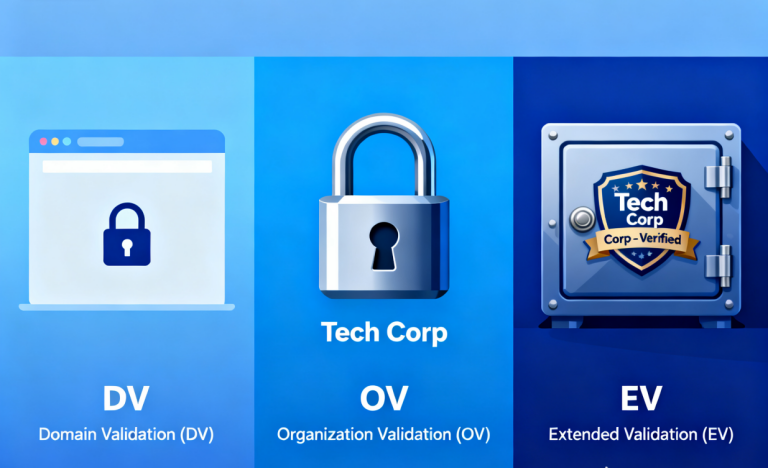
Imagine for a moment that you're in a crowded city square, and a person comes up to you offering you a valuable item. They tell you they're a reputable dealer, but how do you know if you can trust them? You might ask for their business card, their ID, or maybe a full background check. Each step you take to verify their identity and legitimacy provides a different level of trust. This is the exact moment of sudden confusion that hits people when they start to look at SSL certificates. You see a green padlock, and you think, "Great, it's secure!" But what you don't realize is that not all padlocks are created equal. They come with different levels of validation, and understanding the difference is crucial for protecting your business and building customer trust.
We’ve already talked about what an SSL certificate does: it enables HTTPS, encrypts data, and tells browsers that your website is safe. But that’s just the surface level. The real depth lies in how a certificate authority (CA) verifies the identity of the person or organization requesting the certificate. This process is called validation, and it comes in three primary flavors: Domain Validation (DV), Organization Validation (OV), and Extended Validation (EV). Ignoring these distinctions is like assuming a business card and a government ID carry the same weight. They don’t.
Let's dive in and decode these three validation levels so you can confidently choose the right one for your business.
1. The Quickest Handshake: Domain Validation (DV)
This is the most common and basic type of SSL certificate. It's the one you'll most often see on blogs, personal websites, and smaller informational sites. As the name suggests, a DV certificate only validates that you own or control the domain name you're requesting the certificate for. The process is incredibly fast and automated.
How it works: A Certificate Authority verifies your ownership of the domain by sending an email to a pre-approved address (like
admin@yourdomain.com), by having you add a specific DNS record, or by having you upload a specific file to your web server. The entire process can take a matter of minutes.The Trust Factor: A DV certificate provides basic encryption and the green padlock. It confirms to your visitors that the connection between their browser and your website is secure. However, it gives no information about who you are. A visitor can’t click on the padlock and see your business name. This means that a hacker could get a DV certificate for a phishing site, making it look legitimate to an untrained eye, even though the business behind it isn't real. It's the equivalent of a simple key that locks your door, but you still don't know who owns the house.
Best for: Personal blogs, informational websites, small projects, and any site that doesn't handle sensitive customer data or payments. It's the entry-level ticket to the world of secure websites.
2. The Business ID Check: Organization Validation (OV)
An OV certificate takes security and trust a significant step further. This is where the Certificate Authority starts getting serious about verifying the legitimacy of your organization.
How it works: The CA performs a multi-step verification process. First, they confirm domain ownership, just like with a DV certificate. Second, and this is the crucial part, they verify that your organization is a legally registered business. They'll check public business databases, government records, and may even perform a phone verification. This manual review process takes longer, usually a few business days.
The Trust Factor: An OV certificate provides the same strong encryption as a DV certificate, but it adds a layer of verified identity. When a user clicks on the padlock, they can see your company's official name, address, and city listed in the certificate details. This is a powerful trust signal for your visitors. It tells them, "This is not just a random website; it is a legally registered business." For an e-commerce store or any site that asks for personal information, this builds a foundation of credibility that a DV certificate can't. It's like putting a big, official sign with your company's name and address on the storefront—it shows you’re a legitimate, trustworthy operation.
Best for: E-commerce websites, corporate websites, professional service providers, and any business that wants to build a higher level of trust with its customers. It's the ideal choice for most small to medium-sized businesses.
3. The Gold Standard: Extended Validation (EV)
This is the highest level of SSL security and validation available. An EV certificate is for businesses that need to convey the absolute maximum level of trust and authenticity.
How it works: The process is rigorous and comprehensive. The CA not only performs the domain and organization checks from the previous levels but also conducts a deep, manual investigation into your business's legal and physical existence. They'll confirm your physical address, phone number, and a number of other operational details. This rigorous process can take several weeks and is often compared to the kind of background check a bank would perform.
The Trust Factor: An EV certificate provides the same encryption as the others, but its primary purpose is to deliver the highest level of trust. When a user clicks on the padlock, they see the verified name of your organization. It's the digital equivalent of seeing the words "Bank of America" or "PayPal" listed in a trusted way. While modern browsers have moved away from the prominent green address bar that once symbolized EV, the backend verification provides an unparalleled level of credibility. It's a powerful signal that tells visitors, "We are who we say we are, and we've been vetted by a global authority." This is your fortress, your bank vault, your armored car.
Best for: Banks, financial institutions, major e-commerce platforms, and large enterprises that handle highly sensitive data and need to build the strongest possible brand trust.
The Final Verdict: How to Choose
The sudden burst of confusion around DV, OV, and EV certificates often comes from a simple question: "Which one do I need?" The answer is not one-size-fits-all. It depends entirely on your business, your audience, and your goals.
If you're just starting out with a personal blog or a simple website, a DV certificate is a great first step. It gets you HTTPS and a crucial SEO boost.
If you run an e-commerce store or any business that collects customer data, an OV certificate is the sweet spot. It's the perfect balance of trust, security, and cost-effectiveness. It tells your customers you're a real, verifiable business, which can be the difference between a sale and a bounce.
If you're in the financial sector or a major corporation, an EV certificate is a non-negotiable part of your brand identity and security strategy.
Ultimately, choosing the right SSL certificate is about aligning your security with your business's needs. Don’t just settle for the first, easiest option. Take the time to understand the different levels of trust you can offer your customers. It's a small investment that pays massive dividends in reputation, security, and sales.

